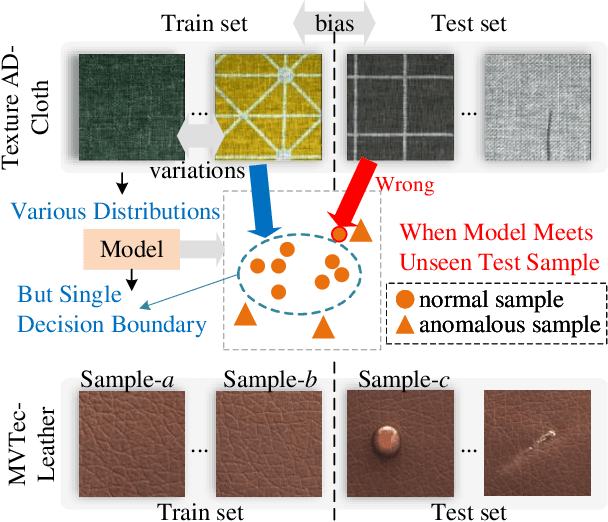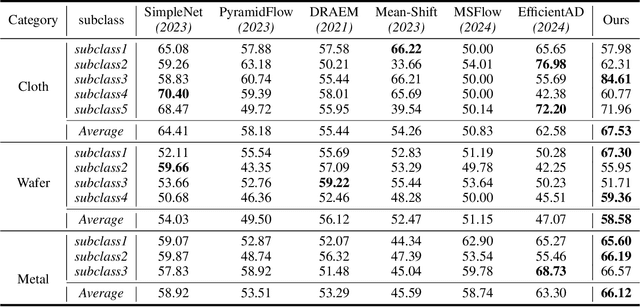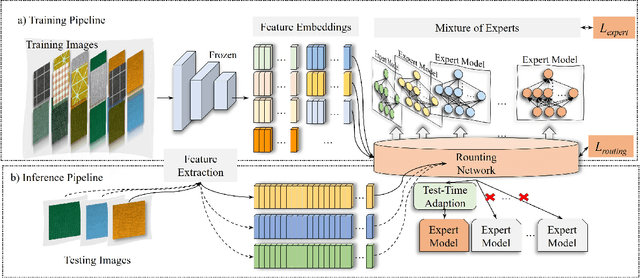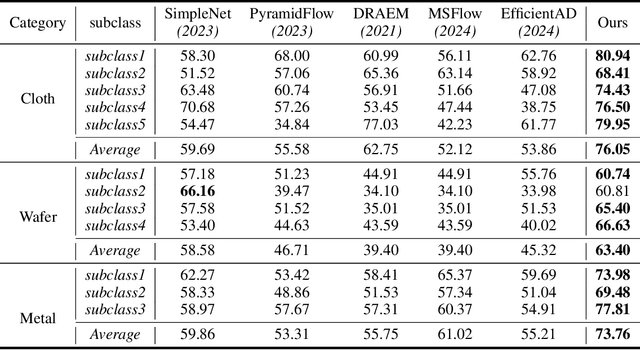Bohan Wang
RobotSmith: Generative Robotic Tool Design for Acquisition of Complex Manipulation Skills
Jun 17, 2025



Abstract:Endowing robots with tool design abilities is critical for enabling them to solve complex manipulation tasks that would otherwise be intractable. While recent generative frameworks can automatically synthesize task settings, such as 3D scenes and reward functions, they have not yet addressed the challenge of tool-use scenarios. Simply retrieving human-designed tools might not be ideal since many tools (e.g., a rolling pin) are difficult for robotic manipulators to handle. Furthermore, existing tool design approaches either rely on predefined templates with limited parameter tuning or apply generic 3D generation methods that are not optimized for tool creation. To address these limitations, we propose RobotSmith, an automated pipeline that leverages the implicit physical knowledge embedded in vision-language models (VLMs) alongside the more accurate physics provided by physics simulations to design and use tools for robotic manipulation. Our system (1) iteratively proposes tool designs using collaborative VLM agents, (2) generates low-level robot trajectories for tool use, and (3) jointly optimizes tool geometry and usage for task performance. We evaluate our approach across a wide range of manipulation tasks involving rigid, deformable, and fluid objects. Experiments show that our method consistently outperforms strong baselines in terms of both task success rate and overall performance. Notably, our approach achieves a 50.0\% average success rate, significantly surpassing other baselines such as 3D generation (21.4%) and tool retrieval (11.1%). Finally, we deploy our system in real-world settings, demonstrating that the generated tools and their usage plans transfer effectively to physical execution, validating the practicality and generalization capabilities of our approach.
AdamS: Momentum Itself Can Be A Normalizer for LLM Pretraining and Post-training
May 22, 2025Abstract:We introduce AdamS, a simple yet effective alternative to Adam for large language model (LLM) pretraining and post-training. By leveraging a novel denominator, i.e., the root of weighted sum of squares of the momentum and the current gradient, AdamS eliminates the need for second-moment estimates. Hence, AdamS is efficient, matching the memory and compute footprint of SGD with momentum while delivering superior optimization performance. Moreover, AdamS is easy to adopt: it can directly inherit hyperparameters of AdamW, and is entirely model-agnostic, integrating seamlessly into existing pipelines without modifications to optimizer APIs or architectures. The motivation behind AdamS stems from the observed $(L_0, L_1)$ smoothness properties in transformer objectives, where local smoothness is governed by gradient magnitudes that can be further approximated by momentum magnitudes. We establish rigorous theoretical convergence guarantees and provide practical guidelines for hyperparameter selection. Empirically, AdamS demonstrates strong performance in various tasks, including pre-training runs on GPT-2 and Llama2 (up to 13B parameters) and reinforcement learning in post-training regimes. With its efficiency, simplicity, and theoretical grounding, AdamS stands as a compelling alternative to existing optimizers.
Selftok: Discrete Visual Tokens of Autoregression, by Diffusion, and for Reasoning
May 18, 2025Abstract:We completely discard the conventional spatial prior in image representation and introduce a novel discrete visual tokenizer: Self-consistency Tokenizer (Selftok). At its design core, we compose an autoregressive (AR) prior -- mirroring the causal structure of language -- into visual tokens by using the reverse diffusion process of image generation. The AR property makes Selftok fundamentally distinct from traditional spatial tokens in the following two key ways: - Selftok offers an elegant and minimalist approach to unify diffusion and AR for vision-language models (VLMs): By representing images with Selftok tokens, we can train a VLM using a purely discrete autoregressive architecture -- like that in LLMs -- without requiring additional modules or training objectives. - We theoretically show that the AR prior satisfies the Bellman equation, whereas the spatial prior does not. Therefore, Selftok supports reinforcement learning (RL) for visual generation with effectiveness comparable to that achieved in LLMs. Besides the AR property, Selftok is also a SoTA tokenizer that achieves a favorable trade-off between high-quality reconstruction and compression rate. We use Selftok to build a pure AR VLM for both visual comprehension and generation tasks. Impressively, without using any text-image training pairs, a simple policy gradient RL working in the visual tokens can significantly boost the visual generation benchmark, surpassing all the existing models by a large margin. Therefore, we believe that Selftok effectively addresses the long-standing challenge that visual tokens cannot support effective RL. When combined with the well-established strengths of RL in LLMs, this brings us one step closer to realizing a truly multimodal LLM. Project Page: https://selftok-team.github.io/report/.
Discrete Visual Tokens of Autoregression, by Diffusion, and for Reasoning
May 12, 2025Abstract:We completely discard the conventional spatial prior in image representation and introduce a novel discrete visual tokenizer: Self-consistency Tokenizer (Selftok). At its design core, we compose an autoregressive (AR) prior -- mirroring the causal structure of language -- into visual tokens by using the reverse diffusion process of image generation. The AR property makes Selftok fundamentally distinct from traditional spatial tokens in the following two key ways: - Selftok offers an elegant and minimalist approach to unify diffusion and AR for vision-language models (VLMs): By representing images with Selftok tokens, we can train a VLM using a purely discrete autoregressive architecture -- like that in LLMs -- without requiring additional modules or training objectives. - We theoretically show that the AR prior satisfies the Bellman equation, whereas the spatial prior does not. Therefore, Selftok supports reinforcement learning (RL) for visual generation with effectiveness comparable to that achieved in LLMs. Besides the AR property, Selftok is also a SoTA tokenizer that achieves a favorable trade-off between high-quality reconstruction and compression rate. We use Selftok to build a pure AR VLM for both visual comprehension and generation tasks. Impressively, without using any text-image training pairs, a simple policy gradient RL working in the visual tokens can significantly boost the visual generation benchmark, surpassing all the existing models by a large margin. Therefore, we believe that Selftok effectively addresses the long-standing challenge that visual tokens cannot support effective RL. When combined with the well-established strengths of RL in LLMs, this brings us one step closer to realizing a truly multimodal LLM. Project Page: https://selftok-team.github.io/report/.
Graph ODEs and Beyond: A Comprehensive Survey on Integrating Differential Equations with Graph Neural Networks
Mar 29, 2025Abstract:Graph Neural Networks (GNNs) and differential equations (DEs) are two rapidly advancing areas of research that have shown remarkable synergy in recent years. GNNs have emerged as powerful tools for learning on graph-structured data, while differential equations provide a principled framework for modeling continuous dynamics across time and space. The intersection of these fields has led to innovative approaches that leverage the strengths of both, enabling applications in physics-informed learning, spatiotemporal modeling, and scientific computing. This survey aims to provide a comprehensive overview of the burgeoning research at the intersection of GNNs and DEs. We will categorize existing methods, discuss their underlying principles, and highlight their applications across domains such as molecular modeling, traffic prediction, and epidemic spreading. Furthermore, we identify open challenges and outline future research directions to advance this interdisciplinary field. A comprehensive paper list is provided at https://github.com/Emory-Melody/Awesome-Graph-NDEs. This survey serves as a resource for researchers and practitioners seeking to understand and contribute to the fusion of GNNs and DEs
Synthetic Video Enhances Physical Fidelity in Video Synthesis
Mar 26, 2025Abstract:We investigate how to enhance the physical fidelity of video generation models by leveraging synthetic videos derived from computer graphics pipelines. These rendered videos respect real-world physics, such as maintaining 3D consistency, and serve as a valuable resource that can potentially improve video generation models. To harness this potential, we propose a solution that curates and integrates synthetic data while introducing a method to transfer its physical realism to the model, significantly reducing unwanted artifacts. Through experiments on three representative tasks emphasizing physical consistency, we demonstrate its efficacy in enhancing physical fidelity. While our model still lacks a deep understanding of physics, our work offers one of the first empirical demonstrations that synthetic video enhances physical fidelity in video synthesis. Website: https://kevinz8866.github.io/simulation/
Project-and-Fuse: Improving RGB-D Semantic Segmentation via Graph Convolution Networks
Jan 31, 2025



Abstract:Most existing RGB-D semantic segmentation methods focus on the feature level fusion, including complex cross-modality and cross-scale fusion modules. However, these methods may cause misalignment problem in the feature fusion process and counter-intuitive patches in the segmentation results. Inspired by the popular pixel-node-pixel pipeline, we propose to 1) fuse features from two modalities in a late fusion style, during which the geometric feature injection is guided by texture feature prior; 2) employ Graph Neural Networks (GNNs) on the fused feature to alleviate the emergence of irregular patches by inferring patch relationship. At the 3D feature extraction stage, we argue that traditional CNNs are not efficient enough for depth maps. So, we encode depth map into normal map, after which CNNs can easily extract object surface tendencies.At projection matrix generation stage, we find the existence of Biased-Assignment and Ambiguous-Locality issues in the original pipeline. Therefore, we propose to 1) adopt the Kullback-Leibler Loss to ensure no missing important pixel features, which can be viewed as hard pixel mining process; 2) connect regions that are close to each other in the Euclidean space as well as in the semantic space with larger edge weights so that location informations can been considered. Extensive experiments on two public datasets, NYU-DepthV2 and SUN RGB-D, have shown that our approach can consistently boost the performance of RGB-D semantic segmentation task.
Mitigating Graph Covariate Shift via Score-based Out-of-distribution Augmentation
Oct 23, 2024Abstract:Distribution shifts between training and testing datasets significantly impair the model performance on graph learning. A commonly-taken causal view in graph invariant learning suggests that stable predictive features of graphs are causally associated with labels, whereas varying environmental features lead to distribution shifts. In particular, covariate shifts caused by unseen environments in test graphs underscore the critical need for out-of-distribution (OOD) generalization. Existing graph augmentation methods designed to address the covariate shift often disentangle the stable and environmental features in the input space, and selectively perturb or mixup the environmental features. However, such perturbation-based methods heavily rely on an accurate separation of stable and environmental features, and their exploration ability is confined to existing environmental features in the training distribution. To overcome these limitations, we introduce a novel approach using score-based graph generation strategies that synthesize unseen environmental features while preserving the validity and stable features of overall graph patterns. Our comprehensive empirical evaluations demonstrate the enhanced effectiveness of our method in improving graph OOD generalization.
Texture-AD: An Anomaly Detection Dataset and Benchmark for Real Algorithm Development
Sep 10, 2024



Abstract:Anomaly detection is a crucial process in industrial manufacturing and has made significant advancements recently. However, there is a large variance between the data used in the development and the data collected by the production environment. Therefore, we present the Texture-AD benchmark based on representative texture-based anomaly detection to evaluate the effectiveness of unsupervised anomaly detection algorithms in real-world applications. This dataset includes images of 15 different cloth, 14 semiconductor wafers and 10 metal plates acquired under different optical schemes. In addition, it includes more than 10 different types of defects produced during real manufacturing processes, such as scratches, wrinkles, color variations and point defects, which are often more difficult to detect than existing datasets. All anomalous areas are provided with pixel-level annotations to facilitate comprehensive evaluation using anomaly detection models. Specifically, to adapt to diverse products in automated pipelines, we present a new evaluation method and results of baseline algorithms. The experimental results show that Texture-AD is a difficult challenge for state-of-the-art algorithms. To our knowledge, Texture-AD is the first dataset to be devoted to evaluating industrial defect detection algorithms in the real world. The dataset is available at https://XXX.
Adapted-MoE: Mixture of Experts with Test-Time Adaption for Anomaly Detection
Sep 09, 2024



Abstract:Most unsupervised anomaly detection methods based on representations of normal samples to distinguish anomalies have recently made remarkable progress. However, existing methods only learn a single decision boundary for distinguishing the samples within the training dataset, neglecting the variation in feature distribution for normal samples even in the same category in the real world. Furthermore, it was not considered that a distribution bias still exists between the test set and the train set. Therefore, we propose an Adapted-MoE which contains a routing network and a series of expert models to handle multiple distributions of same-category samples by divide and conquer. Specifically, we propose a routing network based on representation learning to route same-category samples into the subclasses feature space. Then, a series of expert models are utilized to learn the representation of various normal samples and construct several independent decision boundaries. We propose the test-time adaption to eliminate the bias between the unseen test sample representation and the feature distribution learned by the expert model. Our experiments are conducted on a dataset that provides multiple subclasses from three categories, namely Texture AD benchmark. The Adapted-MoE significantly improves the performance of the baseline model, achieving 2.18%-7.20% and 1.57%-16.30% increase in I-AUROC and P-AUROC, which outperforms the current state-of-the-art methods. Our code is available at https://github.com/.
 Add to Chrome
Add to Chrome Add to Firefox
Add to Firefox Add to Edge
Add to Edge